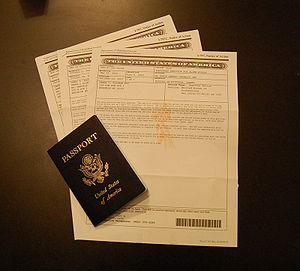From The Peopling of New York City
Contents |
Immigration Laws
Immigration and Nationality Act (INA) – This Act was created in 1952. Before the INA, a variety of statutes governed immigration law but were not organized in one location. The McCarran-Walter bill of 1952, Public Law No. 82-414, collected and codified many existing provisions and reorganized the structure of immigration law. The Act has been amended many times over the years, but is still the basic body of immigration law. The INA is divided into titles, chapters, and sections. Although it stands alone as a body of law, the Act is also contained in the United States Code (U.S.C.). The code is a collection of all the laws of the United States. It is arranged in fifty subject titles by general alphabetic order. Title 8 of the U.S. Code is but one of the fifty titles and deals with "Aliens and Nationality". When browsing the INA or other statutes you will often see reference to the U.S. Code citation.
Naturalization Act of 1790 – This was the first naturalization law in the United States. This act restricted naturalization to free white persons of “good moral character,” who had residency in the country for two years and kept their current state of residency for a year. In 1795 this was increased to five years residence and three years after notice of intent to apply for citizenship, and again to 14 years residence and five years notice of intent in 1798.
19th CENTURY
The Fourteenth Amendment – (1868) This amendment protects children born in the united states. The phrase: "All persons born or naturalized in the United States, and subject to the jurisdiction thereof, are citizens of the United States and of the State wherein they reside" was interpreted by the Supreme Court in the 1898 case United States v. Wong Kim Ark as covering everyone born in the U.S. regardless of the parents citizenship, with the exception of the children of diplomats. In 1870, the law was broadened to allow African Americans to be naturalized. Asian immigrants were excluded from naturalization but not from living in the United States. There were also significant restrictions on some Asians at the state level; in California, for example, non-citizen Asians were not allowed to own land.
Chinese Exclusion Act (1882) - After 228,000 Chinese immigrated between the 1850’s through the 1870’s, congress passed the Chinese Exclusion Act in 1882. This specifically limited any further Chinese immigration into the United States. Chinese had immigrated to the Western United States as a result of unsettled conditions in China, the availability of jobs working on railroads, and the Gold Rush that was going on at that time in California. The "Yellow Peril" expression became popular to justify racism against Asians. The act excluded Chinese laborers from immigrating to the United States for ten years and was the first immigration law passed by Congress that targeted a specific ethnic group. Laborers in the United States and laborers with work visas received a certificate of residency and were allowed to travel in and out of the United States. Amendments in 1884 tightened provisions that allowed previous immigrants to leave and return to the country. It also clarified that the law applied to ethnic Chinese regardless of their country of origin. The Geary Act renewed the Exclusion Act in 1892, which kept it in effect for another ten years and then renewed again in 1902. It was later repealed in 1943, even though large scale Chinese immigration did not occur until 1965.
20th CENTURY
Gentleman’s Agreement (1907) – This was a protocol where Japan agreed to stop issuing passports to her citizens who wanted to emigrate to the U.S. In practice, the Japanese government compromised with its prospective emigrants and continued to give passports to the Territory of Hawaii where many Japanese resided. Once in Hawaii, it was easy for the Japanese to continue on to Japanese settlements on the west coast if they so desired. In the decade of 1901 to 1910, 129,000 Japanese immigrated to the U.S. or Hawaii, nearly all were males and on five year work contracts and 117,000 more came in the decades from 1911 to 1930. How many of them stayed and how many returned at the end of their contracts is unknown but it is estimated that about one-half returned. Again this immigrant flow was at least 80% male and the demand for female Japanese immigrants almost immediately arose. This need was met in part by what are called "postcard wives" who immigrated to new husbands who had chosen them on the basis of their pictures. (Similar marriages also occurred in nearly all cultures throughout the female-starved West). The Japanese government finally quit issuing passports to the Territory of Hawaii for single women in the 1920s.
1882 – Congress banned person because of poor health or lack of education. A law banned entry of “lunatics” and infectious disease carriers.
Anarchist Exclusion Act (1901) – This act was passed after the assassination of President William McKinley by an anarchistof immigrant parentage to exclude unknown agitators.
Immigration Act of 1917 – A literacy requirement was added for incoming immigrants.
Emergency Quota Act (1921) - which established national immigration quotas. The quotas were based on the number of foreign-born residents of each nationality who were living in the United States as of the 1910 census.
United States v. Bhagat Singh Thind (1923) - created the official stance to classify Indians as non-white, which at the time retroactively stripped Indians of citizenship, since zealous prosecutors argued Indian Americans had gained citizenship illegally.
The California Alien Land Law of (1913) - prohibited these aliens from owning land property, thus effectively stripping Indian Americans from land rights. While the decision was placating racist Asiatic Exclusion League (AEL) demands, spurned by growing outrage at the Turban Tide/Hindoo Invasion alongside the pre-existing outrage at the "Yellow Peril", and while more recent legislation influenced by the civil-rights movement has removed much of the statutory discrimination against Asians, no case has overturned this 1923 classification.
Immigration Act of 1924 – also known as the Johnson –Reed Act replaced the emergency system under the through the National Origins Formula.
1932-1940 - President Roosevelt and the State Department essentially shut down immigration during the Great Depression as immigration went from 236,000 in 1929 to 23,000. This was accompanied by voluntary repatriation to Europe and Mexico, and coerced repatriation and deportation of between 500,000 and 2 million Mexican Americans, mostly citizens, in the Mexican Repatriation. Total immigration in the decade of 1931 to 1940 was 528,000 averaging less than 53,000 a year.
The Luce-Celler Act of 1946 - ended discrimination against Indian Americans and Philippines, who were accorded the right to naturalization, and allowed a meager quota of 100 immigrants per year.
Immigration and Nationality Act of 1952 - (the McCarran-Walter Act) revised the quotas again, basing them on the 1920 census. For the first time in American history, racial distinctions were omitted from the U.S. Code. As could be expected, most of the quota allocation went to immigrants from Ireland, the United Kingdom and Germany who already had relatives in the United States. The anti-subversive features of this law are still in force.
1960’s
The Immigration and Nationality Act Amendments of 1965 (the Hart-Cellar Act)- abolished the system of national-origin quotas. There was, for the first time, a limitation on Western Hemisphere immigration (120,000 per year), with the Eastern Hemisphere limited to 170,000. Because of the family preferences put into immigration law, immigration is now mostly "chain immigration"[citation needed] where recent immigrants who are already here sponsor their relatives. Family related immigration is often outside the quota system.
1980’s
The 1980 Refugee Act- Established policies for refugees redefining "refugee" according to United Nations norms. . Under the Refugee Act, the term "refugee” refers to aliens with a fear of persecution upon returning to their homelands, stemming from their religion, race, nationality, membership in certain social groups, or political opinions. Anyone who delivers a missing American POW or MIA soldier receives refugee status from the United States. A target for refugees was set at 50,000 and the worldwide ceiling for immigrants was reduced to 270,000 annually. To qualify for refugee status under the persecution provision, the refugee applicant must prove actual fear. A proof of actual fear requires meeting both a subjective and an objective test. The subjective test requires that the refugee actually have an honest and genuine fear of being persecuted for some immutable trait, such as religion, race, and nationality. Seekers of asylum must show a fear that membership in a social or political group has caused past persecution or has caused a well-founded fear that persecution will occur upon returning. The applicant meets the objective standard by showing credible and direct evidence that a reasonable possibility of persecution exists upon the applicant's return to the homeland.
Immigration Reform and Control Act (IRCA) - passed, creating for the first time penalties for employers who knowingly hired illegal immigrants.
These penalties are very seldom enforced and forged documents are rampant leading to widespread undocumented immigrant employment. IRCA also contained an amnesty for about 3,000,000 illegal immigrants already in the United States, and mandated the intensification of some of the activities of the United States Border Patrol or INS (now part of Department of Homeland Security, DHS). By one account, the actual number of annual legal immigrants was estimated at 500,000 to 600,000 in 1989.
1990’s
U.S. Commission on Immigration Reform - led by former Rep. Barbra Jordan, ran from 1990 to 1997. The Commission covered many facets of immigration policy, but started from the perception that the “credibility of immigration policy can be measured by a simple yardstick: people who should get in, do get in; people who should not get in, are kept out; and people who are judged deportable are required to leave. From there, in a series of four reports, the commission looked at all aspects of immigration policy. In the first, it found that enforcement was lax and needed improvement on the border and internally. For internal enforcement, it recommended that an automated employment verification system be created to enable workers to distinguish between legal and illegal workers. The second report discussed legal immigration issues and suggested that immediate family members and skilled workers receive priority. The third report covered refugee and asylum issues. Finally, the fourth report reiterated the major points of the previous reports and the need for a new immigration policy. Few of these suggestions were implemented.
1990 Immigration Act - (IMMACT) modified and expanded the 1965 act; it significantly increased the total immigration limit to 700,000 and increased visas by 40 percent. Family reunification was retained as the main immigration criteria, with significant increases in employment-related immigration.
Several pieces of legislation signed into law in 1996 marked a turn towards harsher policies for both legal and illegal immigrants. The Antiterrorism and Effective Death Penalty Act (AEDPA) and Illegal Immigration Reform and Immigrant Responsibility Act (IIRIRA) vastly increased the categories of criminal activity for which immigrants, including green card holders, can be deported and imposed mandatory detention for certain types of deportation cases. As a result, well over 1,000,000 individuals have been deported since 1996.
21st Century
Border Protection, Anti-terrorism, and Illegal Immigration Control Act of 2005 - The act was passed in December 2005 limited to enforcement and focused on both the border and the interior.
Comprehensive Immigration Reform Act of 2006 (CIRA) - CIRA would have given a path to eventual citizenship to a majority of illegal aliens already in the country as well as dramatically increased legal immigration. Although the bills passed their respective chambers, no compromise bill emerged. The net result of Congressional discussions and compromises is that immigrant visa limits set by Congress currently (2009) remain at 700,000 for the total categories of employment, family preference, family immediate, and then there are additional provisions for diversity and a small number of special visas.
Department of Homeland Security – opened in 2003 to foster increased intelligence sharing and dialogue between agencies responsible for responding to domestic emergencies, such as natural disaster and domestic terrorism. Within this department there were many different agencies: U.S. Customs and Border Enforcement, U.S. Citizenship and Immigration Services (USCIS), and U.S. Immigration and Customs Enforcement (ICE). These were all formerly handled by INS.
Deportation - Deportation refers to the official removal of an alien from the United States. The U.S. government can initiate deportation proceedings against aliens admitted under the INA that commit an aggravated felony within the United States after being admitted. An alien's failure to register a change of address renders the alien deportable, unless the failure resulted from an excusable circumstance or mistake. If the government determines that a particular alien gained entry into the country through the use of a falsified document or otherwise fraudulent means, the government has the grounds to deport. Other common grounds for deportation include the following: aiding or encouraging another alien to enter the country illegally; engaging in marriage fraud to gain U.S. admission; participating in an activity that threatens the U.S.'s national security; voting unlawfully; and failing to update the government with a residential address every three months, regardless of whether the address has changed. The last of these policies served as the grounds for the government to deport 2,000 Pakistanis following the September 11th attacks. If the government brings a proceeding for deportation because of fraud or falsification, the government bears the burden of proving by clear and convincing evidence that alleged falsification or fraud occurred and that the falsification or fraud proved material to the granting of admission to the alien. Upon such a proof, the government has established a rebuttable presumption that the alien gained admission through material falsification or fraud. To rebut the presumption, the alien must demonstrate by a preponderance of the evidence that admission would have been granted even without the falsification or fraud.
Prerequisites
Green Card
Green Card – A green card is an issuance of permanent residence. There are three main types that an immigrant may obtain: Lottery based green card, Family based, and Employment based.
- Lottery - Each year the Diversity Visa (DV) Lottery program grants 50,000 permanent resident visas ("green cards") to individuals who meet strict eligibility requirements from countries with low rates of immigration to the United States. This official U.S. government program aims to diversify the United States population by creating an immigration opportunity for under-represented groups. Properly completed entries are entered into a computer-generated lottery and winners are randomly selected. Winners and their family members are able to live, work, and study in the United States.
- Family - a U.S. Citizen or Lawful Permanent Resident must sponsor a foreign national. Only certain family members are eligible. Getting a family-based Green Card is a two-step process. The first step is the “Immigrant Petition” which establishes that a qualifying relationship exists between the U.S. Citizen or Lawful Permanent Resident and the Green Card applicant. The second step is the Green Card application. If the sponsor is a U.S. Citizen and the Green Card applicant is a spouse, sibling, parent or minor child who is currently in the U.S., then these two steps can usually be combined into one. Otherwise, applicants must wait for the Immigrant Petition to be approved before they can move on to the Green Card application. Submitting the Form I-130, Immigrant Petition is the first step in sponsoring your family member for Lawful Permanent Resident ("Green Card") status.
- Employment - in order to apply for an Employment-Based Green Card, a qualifying U.S. employer must sponsor a foreign applicant. For most employer sponsors, this involves submitting a Labor Certification Application. The Labor Certification is a test of the labor market to determine whether there are any qualified U.S. workers who are willing to do the job that is offered to the foreign applicant. Only employers who are unable to find qualified U.S. workers to fill the vacant position may sponsor a foreign national for a Green Card through the Labor Certification process. Labor Certification can be a difficult and time-consuming process. In some situations, employees may be able to obtain an Employment-Based Green Card without first obtaining Labor Certification. Beneficiaries of an approved Labor Certification are not always immediately eligible to apply for a Green Card. Green Card applications are accepted based on a tiered preference system, with priority going to foreign nationals who will fill jobs that require an advanced degree and experience. Applicants who qualify in one of the categories that do not require Labor Certification obtain a Green Card faster than applicants whose prospective employers are required to test the labor market.
VISA
Visa’s - In general, to be eligible to apply for an immigrant visa, a foreign citizen must be sponsored by a U.S. citizen relative(s), U.S. lawful permanent resident, or by a prospective employer, and be the beneficiary of an approved petition filed with U.S. Citizenship and Immigration Services (USCIS). The next step is preliminary processing for a visa with the Department of State, National Visa Center. There are different kinds of visa’s to be issued: Diversity Visa, Immediate Relative and Family Sponsored, Marriage to a Foreign National, Employer Sponsored, and Special Immigrants
- Diversity Visa Program - Visas provided are drawn from countries with low rates of immigration to the U.S. Unlike other immigrant types, Diversity Visas (DV) do not require a U.S. sponsor, and therefore a petition is not needed.
- Family Immigration - A lawful permanent resident is a foreign national who has been granted the privilege of permanently living and working in the United States. If you want to become a lawful permanent resident based on the fact that you have a relative who is a citizen of the United States or is a lawful permanent resident, your relative in the U.S. will need to sponsor you and prove he/she has enough income or assets to support you, the intending immigrants when in the United States.
- Employment - The Immigration and Nationality Act provides a yearly minimum of 140,000 employment-based immigrant visas, which are divided into five preference categories. They may require a labor certification from the U.S. Department of Labor (DOL), and the filing of a petition with United States Citizenship and Immigration Services in the Department of Homeland Security (USCIS).
A view on current immigration laws: http://news.yahoo.com/s/ap/20100510/ap_on_re_us/us_immigration_architect
Return to:
I want to be an American, but how?





